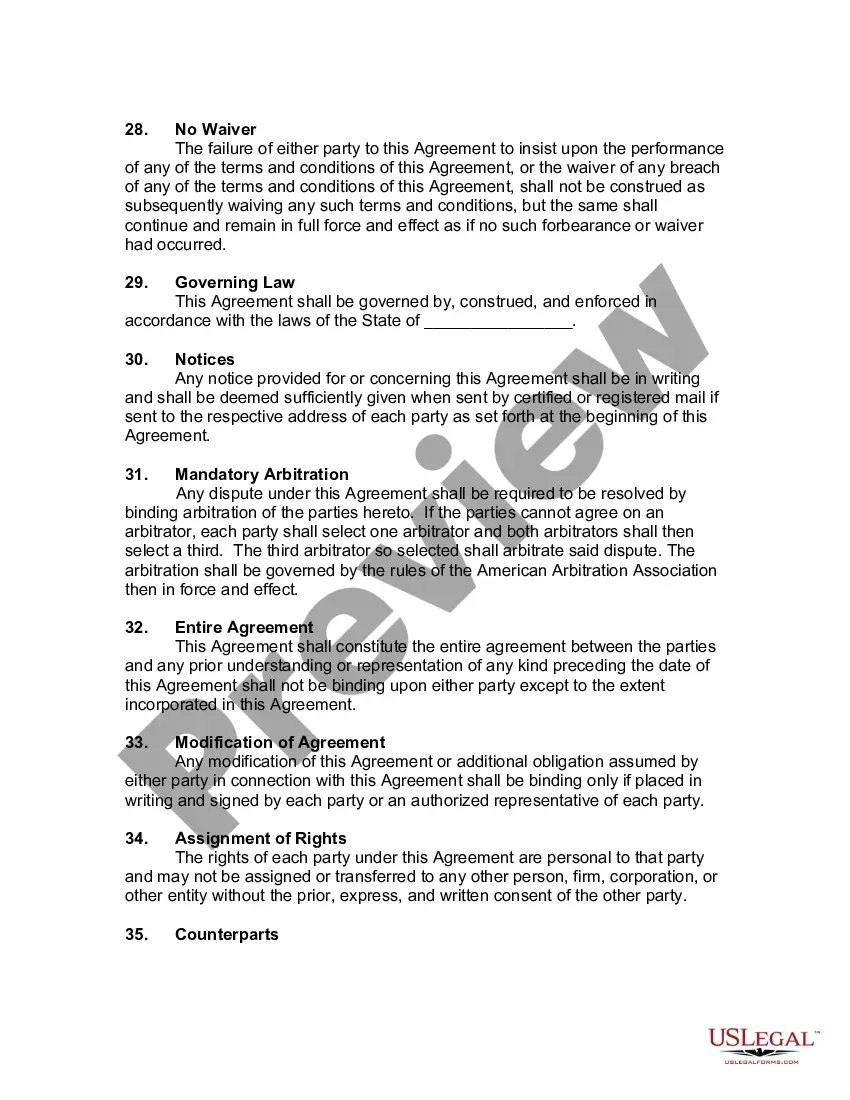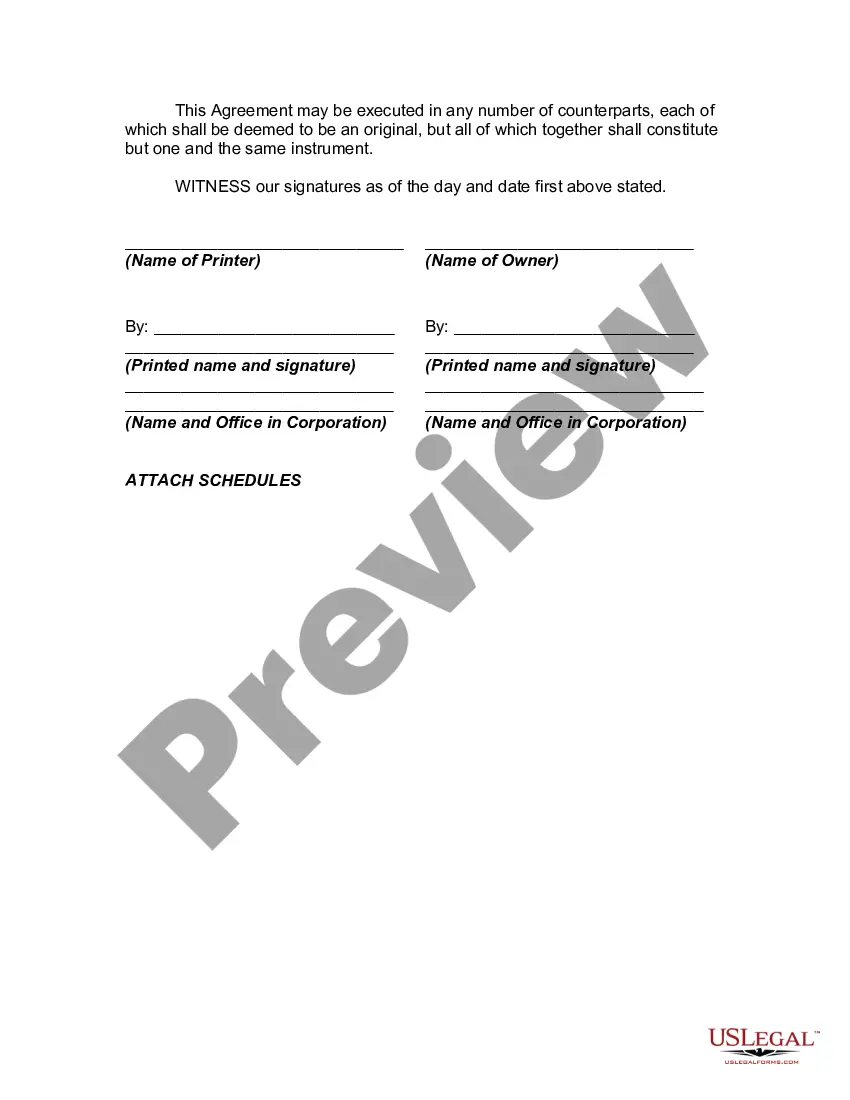A requirements contract is a contract between a supplier or manufacturer and a buyer, in which the supplier agrees to sell all the particular products that the buyer needs, in return for which, the buyer agrees to purchase the goods exclusively from the supplier. It is an agreement to purchase all actual needs of specific property or services during a specified period from a particular supplier. A requirements contract is a contract in which the purchaser agrees to buy all of its needs of a specified material from a particular supplier, and the supplier agrees, in turn, to fill all of the purchaser's needs during the period of the contract.
Colorado Printing Contract with a Company that Owns Monthly Magazine: A Comprehensive Guide Introduction: A Colorado printing contract with a company that owns a monthly magazine is an agreement that outlines the terms and conditions for printing services provided by a printing company based in Colorado to a company that publishes a monthly magazine. This contract ensures a smooth and efficient printing process while safeguarding the interests of both parties involved. There can be various types of printing contracts used in such arrangements, some of which are mentioned below: 1. Offset Printing Contract: Offset printing is a popular method used in magazine printing as it offers high-quality, crisp prints with vibrant color reproduction. This type of contract will specify the use of offset printing technology and outline the various parameters, such as paper type, ink quality, finishing options, and delivery schedules. 2. Digital Printing Contract: Digital printing is a more versatile and cost-effective option suitable for short-run and quick turnaround projects. This type of contract will focus on the use of digital printing technology, including specifications for toners, paper weights, image resolutions, and file formats. It may also cover variable data printing if the magazine requires to be personalized or customized pages. 3. Binding and Finishing Contract: This contract type focuses on the binding and finishing options for the printed magazines. It includes details about binding methods like saddle stitching, perfect binding, or spiral/coil binding, as well as the specification for cover materials like gloss or matte lamination, foil stamping, embossing, or spot UV coating. 4. Distribution Contract: While not directly related to printing, a distribution contract can be included in the overall agreement between the printing company and the magazine publisher. This contract will outline the responsibilities and terms for delivering the printed magazines to their intended distribution channels, whether it's mailing services, newsstands, subscribers, or other outlets. Key Elements of a Colorado Printing Contract: Regardless of the specific type of printing contract used, certain elements should be included to ensure a clear understanding and a mutually beneficial partnership. Let's now delve into the key components that a Colorado printing contract with a company that owns a monthly magazine should cover: 1. Scope of Work: Clearly define the scope of work by detailing the specific printing services, such as color printing, page layout, proofreading, pagination, and image retouching, that the printing company will provide for each issue of the magazine. 2. Specifications and Standards: Outline the technical specifications and standards related to printing quality, color accuracy, image resolution, paper weight and type, and any other specific requirements unique to the magazine's brand guidelines. 3. Pricing and Payment Terms: Agree upon the pricing structure for the printing services, including any applicable taxes or additional charges. Define the payment terms, such as deposit requirements, invoice due dates, and acceptable payment methods. 4. Production Timeline: Set realistic production timelines for each stage of the printing process, including prepress, printing, binding, finishing, and delivery. Ensure that both parties have a clear understanding of the deadlines to avoid any delays or misunderstandings. 5. Quality Assurance: Specify the quality control measures that the printing company will undertake to ensure the magazines meet industry standards and the publisher's expectations. This may include providing physical proof copies, conducting press checks, or implementing a color management system. 6. Confidentiality and Intellectual Property: Include clauses that protect both parties' confidential information and intellectual property rights, ensuring that the magazine's content, design elements, and proprietary information are not shared or used by the printing company for any purposes other than the agreed printing services. 7. Termination and Legal Recourse: Establish the grounds and procedures for terminating the contract by either party, as well as any legal remedies available in case of contract breaches or disputes. Conclusion: A Colorado printing contract with a company that owns a monthly magazine is a crucial agreement that governs the printing process and delivery of a high-quality publication. By understanding the types of printing contracts available and including key elements in the agreement, both the printing company and the magazine publisher can establish a strong partnership that ensures consistent and visually appealing printed magazines.Colorado Printing Contract with a Company that Owns Monthly Magazine: A Comprehensive Guide Introduction: A Colorado printing contract with a company that owns a monthly magazine is an agreement that outlines the terms and conditions for printing services provided by a printing company based in Colorado to a company that publishes a monthly magazine. This contract ensures a smooth and efficient printing process while safeguarding the interests of both parties involved. There can be various types of printing contracts used in such arrangements, some of which are mentioned below: 1. Offset Printing Contract: Offset printing is a popular method used in magazine printing as it offers high-quality, crisp prints with vibrant color reproduction. This type of contract will specify the use of offset printing technology and outline the various parameters, such as paper type, ink quality, finishing options, and delivery schedules. 2. Digital Printing Contract: Digital printing is a more versatile and cost-effective option suitable for short-run and quick turnaround projects. This type of contract will focus on the use of digital printing technology, including specifications for toners, paper weights, image resolutions, and file formats. It may also cover variable data printing if the magazine requires to be personalized or customized pages. 3. Binding and Finishing Contract: This contract type focuses on the binding and finishing options for the printed magazines. It includes details about binding methods like saddle stitching, perfect binding, or spiral/coil binding, as well as the specification for cover materials like gloss or matte lamination, foil stamping, embossing, or spot UV coating. 4. Distribution Contract: While not directly related to printing, a distribution contract can be included in the overall agreement between the printing company and the magazine publisher. This contract will outline the responsibilities and terms for delivering the printed magazines to their intended distribution channels, whether it's mailing services, newsstands, subscribers, or other outlets. Key Elements of a Colorado Printing Contract: Regardless of the specific type of printing contract used, certain elements should be included to ensure a clear understanding and a mutually beneficial partnership. Let's now delve into the key components that a Colorado printing contract with a company that owns a monthly magazine should cover: 1. Scope of Work: Clearly define the scope of work by detailing the specific printing services, such as color printing, page layout, proofreading, pagination, and image retouching, that the printing company will provide for each issue of the magazine. 2. Specifications and Standards: Outline the technical specifications and standards related to printing quality, color accuracy, image resolution, paper weight and type, and any other specific requirements unique to the magazine's brand guidelines. 3. Pricing and Payment Terms: Agree upon the pricing structure for the printing services, including any applicable taxes or additional charges. Define the payment terms, such as deposit requirements, invoice due dates, and acceptable payment methods. 4. Production Timeline: Set realistic production timelines for each stage of the printing process, including prepress, printing, binding, finishing, and delivery. Ensure that both parties have a clear understanding of the deadlines to avoid any delays or misunderstandings. 5. Quality Assurance: Specify the quality control measures that the printing company will undertake to ensure the magazines meet industry standards and the publisher's expectations. This may include providing physical proof copies, conducting press checks, or implementing a color management system. 6. Confidentiality and Intellectual Property: Include clauses that protect both parties' confidential information and intellectual property rights, ensuring that the magazine's content, design elements, and proprietary information are not shared or used by the printing company for any purposes other than the agreed printing services. 7. Termination and Legal Recourse: Establish the grounds and procedures for terminating the contract by either party, as well as any legal remedies available in case of contract breaches or disputes. Conclusion: A Colorado printing contract with a company that owns a monthly magazine is a crucial agreement that governs the printing process and delivery of a high-quality publication. By understanding the types of printing contracts available and including key elements in the agreement, both the printing company and the magazine publisher can establish a strong partnership that ensures consistent and visually appealing printed magazines.









